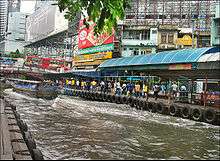Khlong Saen Saep

Khlong Saen Saep (Thai: คลองแสนแสบ, IPA: [kʰlɔ̄ːŋ.sɛ̌ːn.sɛ̀ːp]) is a canal (khlong) in central Thailand, connecting the Chao Phraya River to Prachinburi Province and Chachoengsao. A portion of the canal is used for public transport by an express boat service in Bangkok. The canal is connected to more than 100 sub-canals,[1] though most of the other canals do not have a regular transport service.
History

The Saen Saep Canal was built on the order of King Rama III during a conflict between Siam and Annam over Cambodia in order to establish water transport for soldiers and weapons. Construction began in 1837 and was finished in three years.[2] Klong Saen Saep was once filled with lotus plants. King Mongkut in his fourth reign (1851-1868) built Sa Pathum Palace (Lotus Pond Palace) in Siam District. The name of the palace and present-day Pathum Wan District are derived from it.[3]
The Saen Saep starts from Maha Nak Canal (Khlong Maha Nak) (Thai: คลองมหานาค) around Mahakan Fort (Thai: ป้อมมหากาฬ) in Bangkok. In Chachoengsao Province it ends in the Bang Pa Kong River.
Environmental
The Saen Saep Canal is one of Bangkok's major drainage arteries. It is also heavily polluted. Prime Minister Prayut Chan-o-cha initiated a two-year effort to clean up the canal in 2017-2018. A survey by the Pollution Control Department (PCD) concluded that there are 631 potential sources of pollution along the canal, including 62 hospitals, 107 restaurants, 14 markets, 66 hotels, 144 condominiums, 81 department stores, and 157 homes. Between October 2015 and January 2017, the department inspected 210 of the 631 potential polluters and found that 40 percent of hotels, 23 percent of hospitals, 20 percent of department stores, and 50 percent of condominiums discharged waste water into the canal in contravention of existing laws. To clean up the canal Natural Resources and Environment Minister General Surasak Kanjanarat proposes charging waste water treatment fees to households and tourists. "If we do nothing, all rivers and canals in the next 20 years will be completely ruined. And if you are not ready to pay now, you might have to pay more in the future.", he said. The PCD study that the charge should be 0.43 baht per cubic metre. This would bring in 5.3 billion baht per year. Plans have been made to charge each tourist 50 baht for waste water treatment which will bring in an additional 1.5 billion baht of revenue each year, assuming 29.9 million tourists, the number who visited in 2016. The PCD intends to study wastewater treatment in an additional 21 districts with sub-canals linked to the Saen Saep Canal.[1]
Transport
An express boat service operates on the Saen Saep between Pom Prap Sattru Phai and Bang Kapi Districts, providing ferry service in traffic-congested central Bangkok. The service has a checkered reputation, due to the polluted water in the khlong and the slapdash nature of the service. The northern line ends at Golden Mount, and the southern line ends at NIDA. Boats go past Watthana and Huai Khwang Districts, running parallel to Petchaburi Road.
References
- 1 2 Wipatayotin, Apinya (26 January 2017). "Pollution fee high on canal clean-up list". Bangkok Post. Retrieved 26 January 2017.
- ↑ Tanabe, Shigeharu (1977). "Historical Geography of the Canal System in the Chao Phraya Delta". Journal Of The Siam Society. 65 (2).
- ↑ "Bangkok's Crucible of Construction". 2Bangkok.com. Archived from the original on 18 November 2005. Retrieved 26 January 2017.
External links
| Wikimedia Commons has media related to Khlong Saen Saeb. |
Coordinates: 13°44′57.88″N 100°32′25.04″E / 13.7494111°N 100.5402889°E